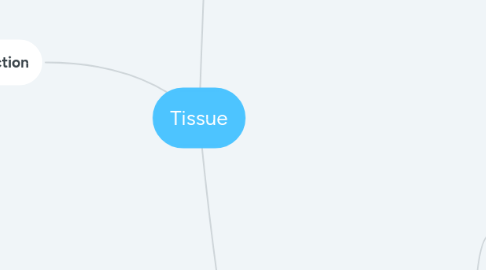
1. Function
1.1. Connective
1.2. Epithelial
1.2.1. protection, absorption, secretion and excretion.
1.3. Muscle
1.4. Nervous
2. Types
2.1. Connective
2.2. Epithelial
2.3. Muscle
2.3.1. Skeletal
2.3.1.1. A. Structure: Skeletal muscle are long, cylindrical, multinucleated cells with obvious striations.
2.3.1.1.1. **striations are the alternating light and dark bands we see in the muscle tissue. The light band is the protein filament actin and the dark band is the protein filament myosin which are responsible for muscle contraction.
2.3.1.2. B. Function: Voluntary movements
2.3.1.3. C. Location: Found in the skeletal muscles attached to bone and occasionally to skin.
2.3.2. Cardiac
2.3.2.1. A. Structure: Branching, striated, generally uninucleated cells that interdigitate at specialized junctions (intercalated disc).
2.3.2.2. B. Function: As it contracts, it propels blood into the circulation; involuntary control
2.3.2.3. C. Location: The walls of the heart.
2.3.3. Smooth
2.3.3.1. A. Structure: Spindle-shaped cells with central nuclei; no striations, cells arranged closely to form sheets.
2.3.3.2. B. Function: Propels substances or objects along internal passageways; involuntary control.
2.3.3.3. C. Location: Mostly in the walls of hollow organs like the digestive tract, bladder, arteries and other internal organs.
2.4. Nervous
3. Classification
3.1. Connective
3.1.1. Connective Tissue Proper
3.1.1.1. Areolar C.T.
3.1.1.1.1. Description: Gel-like matrix with all three types of fibers; Cells: fibroblast, macrophages, mast cells, and some white blood cells
3.1.1.1.2. Function: Wraps and cushions organs; its macrophages phagocytize bacteria; plays important role in inflammation; holds tissue fluid
3.1.1.1.3. Location: beneath the skin (underlies epithelial tissue); around blood vessels, muscles and nerves
3.1.1.2. Adipose C.T.
3.1.1.2.1. Description: Matrix as in areolar connective tissue, but very sparse; closely packed adipocytes, or fat cells, have nucleus pushed to the side by large fat droplet.
3.1.1.2.2. Function: Provides reserve food fuel; insulates against heat loss; supports and protects organs.
3.1.1.2.3. Location: Under skin in the hypodermis; around kidneys and eyeballs; within abdomen; in breasts.
3.1.1.3. Reticular C.T.
3.1.1.3.1. Description: Compose mainly of RETICULAR FIBERS
3.1.1.3.2. Function: Fibers form a soft internal skeleton (stroma) that supports other cell types including white blood cells, mast cells, and macrophages.
3.1.1.3.3. Location: Lymph nodes, Bone marrow, Spleen, Liver
3.1.1.4. Dense Regular C.T.
3.1.1.4.1. Description: PARALLEL arrangement of fibers (it has more collagen and few elastic fibers)
3.1.1.4.2. Cells: fibroblast It can withstand TENSION when pulling force is applied in one direction.
3.1.1.4.3. Examples: TENDONS and LIGAMENTS, Aponeuroses and Fascia Muscle – TENDONS – Bone Bone – LIGAMENTS – Bone
3.1.1.5. Dense Irregular C.T.
3.1.1.5.1. Description: IRREGULAR arrangement of Fibers (made primarily of Collagen fibers and few elastic fibers)
3.1.1.5.2. Cells: Fibroblast, Defense cells and fats cells may be present It is able to withstand tension exerted in many directions; provides structural strength.
3.1.1.5.3. Location: Capsule surrounding the joints, dermis of the skin, outer covering of body tubes like arteries.
3.1.1.6. Elastic C.T.
3.1.1.6.1. Description: Contains a high proportion of Elastic Fibers.
3.1.1.6.2. Function: Allows recoil of tissue after stretching.
3.1.1.6.3. Location: Wall of Aorta and other large arteries. Wall of bronchial tubes (respiratory passages found in the lungs)
3.1.2. Specialized Connective Tissue
3.1.2.1. Blood
3.1.2.1.1. a “specialized” connective tissue because its Extracellular matrix is different from the other C.T
3.1.2.1.2. While the ECM of other C.T. is secreted by their cells, blood is an exception. Its ECM which is the PLASMA is not secreted by its cells (WBC, RBC and platelets). Blood’s ECM also doesn’t contain fibers
3.1.2.2. Bone
3.1.2.2.1. Calcified ground substance
3.1.2.3. Cartilage
3.1.2.3.1. Gelatinous ground substance
3.1.2.3.2. Hyaline Cartilage
3.1.2.3.3. Elastic Cartilage
3.1.2.3.4. Firbrocartilage
3.2. Epithelial
3.2.1. Shape
3.2.1.1. Squamous
3.2.1.1.1. (flattened cells) cell width is larger than cell height
3.2.1.2. Cuboidal
3.2.1.2.1. (cube-like cells) cell width is equal to cell height
3.2.1.3. Columnar
3.2.1.3.1. (column-like cells) cell height is larger than cell width
3.2.2. Arrangement
3.2.2.1. Simple
3.2.2.1.1. one cell layer
3.2.2.2. Stratified
3.2.2.2.1. several layers of cells
3.2.2.3. Pseudostratified
3.2.2.3.1. seems to have several layers due to various positioning of cell nuclei (but it is a single layer because all cells extend from the basement membrane up to the surface)
3.2.2.4. Transitional
3.2.2.4.1. consists of several layers of cells and is designed to stretch and return to a normal state without damage.
3.2.3. Function
3.2.3.1. Mucous membrane
3.2.3.1.1. an epithelial tissue that secretes mucus. It is found lining many body cavities and tubular organs including the gut and respiratory passages.
3.2.3.2. Glandular epithelium
3.2.3.2.1. forms the glands. Glands are actually involutions of epithelial cells. Glands produce and secrete specific products.
3.2.3.3. Endothelium
3.2.3.3.1. a simple squamous epithelium that lines the interior of the circulatory vessels and heart.
3.2.3.4. Mesothelium
3.2.3.4.1. Simple squamous epithelium that lines the peritoneal, pleural and pericardial cavities and covers viscera (internal organs).
3.3. Nervous
3.3.1. Neurons
3.3.1.1. is the one responsible for conducting nerve impulses (electrical signals transmitted along the nerve) throughout the nervous system
3.3.1.1.1. Dendrites
3.3.1.1.2. Cell body
3.3.1.1.3. Axon
3.3.2. Neuralgia
3.3.2.1. is a group of cells that provide support and nourishment to the neurons.

